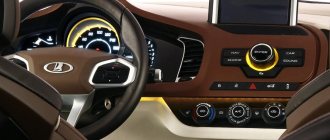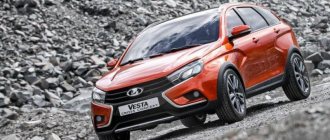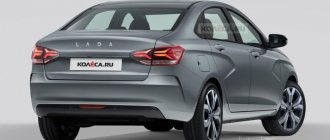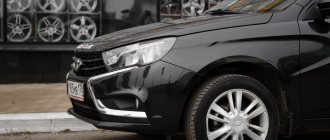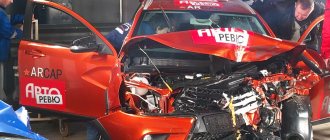What will the front-wheel drive Lada Vesta SV Cross give?
Despite the all-wheel drive, off-road travel will not seem like an easy walk. It is worth understanding that the passable abilities are moderately developed. However, despite the differences from more successful competitors, the new modification will be able to surprise its owner:
- controllability, especially when the road is icy or dirty, will increase significantly;
- the transmission of torque to all wheels will make the driving style less significant, which will definitely contribute to the comfort of driving for beginners;
- irregularities that are constantly encountered on the road, including speed bumps, will no longer bother you even at night;
- The equipment is always top-notch with the manufacturer’s most powerful production engine.
Ground clearance of 203 mm is an impressive result. Improving the suspension will clearly reveal the full potential of the SW Cross. Getting there on roads of any quality is a reality. It’s another matter to decide to go completely off-road, so beloved by some avid fishermen and hunters. Here the likelihood of slipping is higher, so it’s not worth the risk without an additional traveler’s kit.
First test of Lada Vesta SW and SW Cross. Vesta Ver.2.0: universal and improved
They say they wait three years for what was promised. We waited only two times for the station wagon: exactly that much has passed since the premiere of the bright orange concept in Moscow, which took place even before the start of sales of sedans. Then they promised us: expect a station wagon next fall. And they even hinted that the appearance of an all-wheel drive version is possible. Alas, the station wagon was not ready in the fall of 2016, and VAZ today is trying not to talk about all-wheel drive at all, as well as the prospects for a version with an automatic transmission...
A regular SW station wagon cannot be distinguished from a sedan from the front. The SW Cross version looks original due to the modified front bumper. And it's not just the black protective plastic overlay, which, according to chief designer Steve Mattin, "emphasizes the X-face."
In the meantime, Steve Mattin is giving us another lecture about the new Lada design style, about its genetic “X-code” and about the details and touches with which this very code is manifested and emphasized. But the most important information for the client is that the rear lights and bumper of a regular station wagon are unified with those of a sedan in order to reduce costs.
Few people notice that it is drawn not only on the front, but also on the back. The characteristic shape can be seen in the lines of the stamped lamps on the bumper. On the SW Cross version this is even more noticeable
Only the SW Cross version has its own bumpers. And even then, mostly due to the “off-road” plastic decor.
With all the desire of the VAZ team to reduce production costs, you can admire the appearance of the new station wagons. Without exaggeration, it is worth saying that these are some of the most beautiful and harmonious “sheds”. However, what kind of “sheds”? The letters SW mean nothing more than Sport Wagon - this is how their creators position these cars. This concept was chosen not only for the sake of creating “beauty”, but also to attract a younger and more active audience, which precisely requires not only practicality, but also an emotional appearance. Yes, in the parking lot of the Sochi airport, the line of Vests with a universal body did not attract much attention - there was no way to recognize the new product from the front. But at the rear... That's where the idea of a "floating roof" and a "shark fin" C-pillar came in handy. Barn? Come on! Even the SW Cross, which looks more brutal and impressive due to its protective body kit and larger 17-inch wheels, is perceived as a gracefully dynamic car.
Fundamentally the interior remains the same. The regular SW station wagon has no differences from sedans at all. The cross version is distinguished by inserts on the panel and seats - in classic silver-gray (pictured) or in brighter and more emotional orange tones. The dashboard is now installed on all Vestas in the so-called “Euro version” - with orange scales. The rear view camera now has dynamic trajectory markings
But SW buyers will receive not only appearance and spaciousness, but also a whole “package” of improvements. Rear disc brakes are now installed on all versions of the Cross and station wagons with a 1.8-liter engine. Didn't the sedan have rear lights? Get an extra light in the ceiling. Was the heated windshield turned on only with the rear window and mirrors? Here's a separate key on the console. Did you complain that the electrically heated front seats were either too hot or turned off? Now it has as many as three stages that turn on sequentially, and the power keys themselves have become clearer and easier to press. In addition, warm pleasure has become available for rear passengers, as well as a folding armrest, a 12-volt socket and a USB port! Instead of a stunted misunderstanding dangling at the end of the back of the driver's seat, there is now a real storage box, the glove compartment has a special organizer lid, and the fuel tank flap is locked with a central lock.
The unsuccessful parody that was still offered for luxury sedans has been replaced by a normal armrest with a box. Electric heating in the front has become three-stage, and the glove compartment now has a microlift, a partition organizer, holders for business cards and even a cup holder
The rear seat itself remains the same, but the headroom has increased by 2.5 cm. Comfort for riders has been increased due to an armrest, electric heating, an additional lampshade and, of course, the ability to recharge their gadgets either from a 12-volt outlet or via a USB connector
Vesta SW is associated with a luxury passenger car. And the abbreviations are the same: remember, there used to be “SV” - sleeping cars? The new station wagon is quite suitable for this role.
But, of course, the main features of station wagons are hidden in the trunks. Looking at the numerous improvements and amenities, I am inclined to suspect that the AvtoVAZ employees in charge of the cargo compartment were trained at IKEA stores. There are not only hooks for bags and two lamp shades, but also a removable roll-up curtain, a 12-volt socket and even a pocket with a shelf where it’s easy to place a bottle of anti-freeze, a can of oil or some other small thing that any normal car owner needs .
In the trunk you can find not just a “sandwich” - a whole “hamburger”! A double false floor, under which lies a double foam organizer, another false floor is hidden under it, and even lower is a full-size (!) spare tire with a built-in organizer. Great! — until he feels the urge to take out the fifth wheel when the cargo compartment is full...
The official trunk volume figures are exactly the same as those of the sedan - 480 liters. But the whole point is how well the cargo space is organized.
The test featured station wagons only with manual transmission with top-end 1.8-liter 122-horsepower engines, for which steep mountain road climbs should not be a problem! Or…? With such volume and power, you would expect easier acceleration. But Vesta SW picks up speed with restraint, with a sense of self-esteem. To confidently storm serpentines, it is necessary that the tachometer needle does not fall below 3000 rpm. I am glad that the background noise, even in such modes, remains at an acceptable level.
The 1.8-liter engine is created on the basis of the 1.6-liter by increasing the piston stroke. The engine was not as torquey as its basic version, but with more thrust, which is more important for a station wagon. 5-speed manual transmission - developed by Renault (the same was installed on the first Vesta with a 1.6-liter engine)
The driver “feels” the “backpack” of the trunk that appears behind him only with his eyes, looking in the rear-view mirrors. On the serpentines from Krasnaya Polyana to the Sochi Olympic Village, the new Vesta SW drives exactly like a sedan: correctly and even at times recklessly. But what’s even more surprising is that the “off-road” version of the universal Vesta with the Cross nameplate also feels good in corners.
On a highway full of turns, the weak return action of the steering must be compensated ... by the driver's hands. This way, return the steering wheel to zero faster than it would happen naturally. If you get used to this, you will be able to appreciate the capabilities of the chassis, which Vesta has very high
Unfortunately, the shortcomings of the steering inherent in sedans have not gone away: the steering wheel still does not fully inform the driver about the position of the front wheels and is also in no hurry to return to zero at the exit of a turn.
If only the rear suspension of a regular station wagon underwent modifications, then to modify the Cross it was necessary to change the front shock absorbers with springs: after all, on the “cross” version the ground clearance was also increased by 25 mm (from 178 to 203 mm). Another nuance that also affects driving performance is the larger 17-inch wheels with low-profile Pirelli tires. In theory, on such “skating rinks” the Cross should have become tougher. In addition, there is a recent example of the raised Kalina and Largus, in which the increase in ground clearance reduced the rebound travel of the suspension, which did not have a very good effect on comfort (especially in the case of Kalina Cross). What to expect from elated Vesta?
Vesta SW Cross turned out to be even better than conventional station wagons and sedans in terms of chassis tuning. The driving experience in the elevated station wagon was a pleasant surprise. In addition, energy efficiency has improved
Surprisingly, the Cross's suspension seems denser and more monolithic! Grippy tires with a lower profile height “break” less, they don’t “lead” as much in sharp turns, and they filter out most road defects even better than the wheels on simple Vestas. The rolls, despite the increased height and center of gravity, no longer began. The only thing in which the raised station wagon is inferior to the usual one is in overcoming deep holes or sharp asphalt joints at speed: impacts occur a little earlier.
Rear disc brakes are, of course, good. Their appearance will please many, but by and large you won’t notice any difference in the quality of deceleration under normal conditions
“Are you sure you upgraded the front stabilizer struts?” The VAZ workers were categorical: “We changed the material of the liners and now the hinges are reliable and durable.” I want to believe…
A separate point in the test program for the SW Cross version was driving on dirt roads. Here you need a clear understanding that an off-road body kit and even increased ground clearance will not turn a front-wheel drive station wagon into a “mud-mover”. On one of the “off-road” sections, the rolled-out passage was blocked by a broken-down Niva, and without a shadow of a doubt I directed the car onto the side of the road washed out by the rain. Yes, in this case the orange Cross broke through thanks to the help of the traction control system. But diagonal hanging showed that Vesta’s electronics are not able to simulate inter-wheel locking - which is what really helps front-wheel drive cars in difficult conditions.
The increase in ground clearance did not affect the suspension travel. But still, when moving under tension, the front wheels begin to slip even before the rear wheels come off. Therefore, it is better to overcome steep terrain bends on Vesta Cross on foot.
Oddly enough, the most important impression from the West station wagon test was not the very appearance of new modifications of the successful model. And not even a thorough study of the luggage compartment, which does not often happen on models of this level. What pleased me most was that AvtoVAZ listened to the criticism and wishes of its customers and carried out a whole range of work to improve the car. Moreover, a considerable part of these improvements are available not only for expensive versions, but also in basic versions. Probably the only serious drawback is the prices: Vesta SW will cost at least 639,900 rubles, and SW Cross cannot be bought for less than 755,900 rubles. But similarly equipped classmates will still be more expensive, and, most importantly, they will not be able to offer a station wagon. Therefore, despite the fact that instead of the once promised all-wheel drive, Vesta only has an increased ground clearance, and instead of an “automatic” there is still a “robot”, I would confidently recommend any of these cars as the most versatile option for a new car in the B+ segment.
Technical characteristics of Lada Vesta SW and SW Cross (manufacturer data)
| Lada Vesta SW | Lada Vesta SW Cross | |||
| Body | ||||
| Type | Station wagon | |||
| Number of seats/doors | 5/5 | |||
| Engine | ||||
| Type | Petrol | |||
| Engine location | Front, transverse | |||
| Number and arrangement of cylinders | 4, in a row | |||
| Working volume, cubic meters cm | 1596 | 1774 | 1596 | 1774 |
| Power, hp at rpm | 106/5800 | 122/5900 | 106/5800 | 122/5900 |
| Torque, Nm at rpm | 148/4200 | 170/3700 | 148/4200 | 170/3700 |
| Transmission | ||||
| Drive unit | Front | |||
| Transmission | 5-speed manual transmission (5-AMT) | 5-speed manual transmission (5-AMT) | 5-speed manual transmission | 5-speed manual transmission (5-AMT) |
| Brakes | ||||
| Front | Ventilated disc | |||
| Rear | Drums | Disk | ||
| Suspension | ||||
| Front | Independent, spring, McPherson | |||
| Rear | Semi-dependent, spring | |||
| Dimensions, volume, weight | ||||
| Length/width/height, mm | 4410/1764/1512 | 4424/1785/1532 | ||
| Wheelbase, mm | 2635 | |||
| Ground clearance, mm | 178 | 203 | ||
| Curb weight, kg | 1280–1330 | 1300–1350 | ||
| Fuel tank volume, l | 55 | |||
| Trunk volume, l | 480–825 | |||
| Tires | 195/55 R16, 185/65 R15 | 205/50 R17 | ||
| Dynamic characteristics | ||||
| Maximum speed, km/h | 174 | 180 (182) | 172 | 180 (181) |
| Acceleration to 100 km/h, sec. | 12,4 (14,4) | 10,9 (12,9) | 12,6 | 11,2 (13,3) |
| Fuel consumption, l/100 km | ||||
| Combined cycle | 7,3 (7,0) | 7,8 (7,6) | 7,5 | 7,9 (7,7) |
| CO2 emissions, g/km, eq. Class | n.d., Euro-5 | |||
| Cost of the car, rub. | ||||
| Basic equipment | 639 900 (664 900) | 697 900 (722 900) | 755 900 | 780 900 (805 900) |
There is no special underbody protection, other than the factory metal crankcase protection, for station wagons. The only visual difference is the bifurcated muffler pipes for the Cross version and a slightly higher body position
| Equipped with security systems | ||
| Lada Vesta SW | Lada Vesta SW Cross | |
| Front airbags (driver/passenger) | + | + |
| Side airbags | O | + |
| Curtain airbags | – | – |
| Driver/passenger knee airbag | – | – |
| Inflatable seat belts for rear passengers | – | – |
| ESP stabilization system | + | + |
| Traction control system TCS | + | + |
| Anti-lock braking system ABS | + | + |
| Brake Assist | + | + |
| Rear View Camera | O | O |
| Parktronic | + | + |
| Parking assistance system | – | – |
| LED headlights | – | – |
| Xenon headlights | – | – |
| Adaptive headlights | – | – |
| Lane Change Assistance System | – | – |
| Marking tracking system | – | – |
| Forward Collision Avoidance System | – | – |
| Traffic Sign Recognition System | – | – |
| Driver fatigue monitoring system | – | – |
| Turning on the hazard warning lights during emergency braking | + | + |
Competitors
The uniqueness of the situation is that there are no direct competitors to the new station wagons on the Russian market. All companies that offered or could offer something similar either stopped selling the corresponding models (for example, Skoda Fabia) or relied on crossovers (Hyundai Creta). Therefore, we will indicate only indirect competitors that are similar in size, cost and cargo transportation capabilities.
Lada Largus
Based on the Renault B0 platform, Largus is essentially nothing more than a slightly modified Dacia Logan MCV station wagon by VAZ. The body and comfort of this model were outdated already at the beginning of production - in 2012 (in fact, Logan was already 8 years old by that time - most models by this age change a generation, and sometimes two). Nevertheless, Largus remains a unique offer on the market not only due to its capacity (there are versions with three rows of seats), but also due to its relatively low cost: from 529,900 rubles. for 5-seaters and from 605,900 rubles. for 7-seater versions.
Lada Largus Cross
A modification of Largus with increased ground clearance by 25 mm appeared at the end of 2014 and was initially positioned as the most prestigious and comfortable version of the model. Like the base model with standard ground clearance, the Cross version is available exclusively with front-wheel drive and a manual transmission. But there is only one engine - a 102-horsepower 1.6-liter Renault K4M (an 87-horsepower VAZ-11189 engine is also available for the regular Largus). As a result, Largus Cross in the only Luxe configuration is offered for 674,900–699,900 rubles. for a 5- or 7-seater car, respectively.
Skoda Rapid
The Czech car is included in our list only because this model is offered not as a sedan, but with a rather rare, but only slightly less practical liftback body (trunk volume - 530 l). The minimum cost of the model is 611,000 rubles. But this is a very modestly equipped car with a 90-horsepower version of the 1.6-liter engine. 110-horsepower Rapids are available at prices starting from RUB 725,000. with “mechanics” and from 770,000 rubles. with automatic transmission. Similar in power to the 1.8-liter Vesta, the 125-horsepower Rapids, which have a 1.4-liter TSI turbo engine and a preselective DSG robot under the hood, are much more expensive: from 911,000 to 990,000 rubles. excluding additional options.
Photobonus
Reasoning about the announced information
The competition is too high. AvtoVAZ understands the full degree of responsibility that was assigned after the announcement of the station wagon. They try to operate only with short-term plans that are carefully coordinated with each other. For now, most of the information is available from third-party sources.
Many are familiar with the data on the current state of affairs: AvtoVAZ prioritizes areas with the least chance of failure. The manufacturer is confident that the market is not yet ready to properly respond to the appearance of the all-wheel drive Lada Vesta SV Cross. All data received from dealers confirms the interest of citizens in purchasing cheaper options.
Autonews
Engine
:
- The new 1.8 liter engine is not very impressive on a mountain road. Vesta goes up strained, requiring a lower gear, or even two.
Transmission
:
- Well adjusted clutch. Everything works without vibrations.
- The gear ratios are also well chosen. The first two gears are well suited for city traffic, while the higher gears are good for highway driving and are economical. Vesta 1.8 drives confidently and accelerates well in the mid-speed zone, but is not distinguished by either powerful traction at the bottom or cheerful spin at high speeds.
Control
:
- A dense, slightly synthetic steering wheel, insensitive at small turning angles, modest rolls and understandable reactions, thanks to which you want and can drive the car along the Sochi serpentines.
Suspension
:
- Due to the redistribution of weight, the characteristics of the rear suspension have changed slightly (the rear springs of the station wagon have been increased by 9 mm), but this is not felt while driving.
- If the standard station wagon handles unevenness and bumps, albeit noticeably, but without crossing the line of comfort, then the Cross’s setup is clearly more asphalt.
- The Cross jumps over rocks without any suspension breakdowns. The standard SW is a little more comfortable in these conditions, but requires a little more careful choice of trajectory (since the ground clearance is lower).
Link to test drive.
Information can be deceiving
The all-wheel drive SW Cross constantly appears in photographs taken by random amateurs. Photos, even if their authenticity is confirmed, are worth absolutely nothing. Such a global project cannot be hidden from the AvtoVAZ team. Journalists would instantly find out about such developments from the lips of the designers themselves, but there is no such information.
AvtoVAZ is still feeling confident without the Lada Vesta SV Cross. There is no need to expose your current state of affairs to risks; it is much more effective to simply adhere to the previously chosen line regarding other models. For now, drivers can just wait, and the search for the truth can safely be postponed until 2022. Next year will bring more surprises, but SW Cross may not be among them.
Tags: all-wheel drive
Possible modifications of all-wheel drive Lada cars
The popular Renault Sandero Stepway and Duster models are often cited as competitors. But X Ray is more compact. So it will win in cross-country ability, which is very important for the Russian car enthusiast. AVTOVAZ President Bo Andersson has already announced that production of the X Ray will begin in early 2016. The Cross modification will be launched a few months later. This man does not waste words and no one doubts that promises will be fulfilled on time.
According to the production manager, Russians are expecting 4 versions of X Ray Cross. Which ones exactly will be known very soon. By this time, information about the all-wheel drive Vesta may appear. Then it will become known about other details and characteristics of the machines. In the same year, it is planned to expand the body series with a station wagon. The hatchback will appear a little later. Perhaps even in a year. This is explained not so much by production problems, but by the priority determined by the requests of potential buyers.

